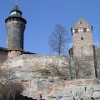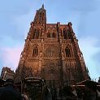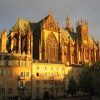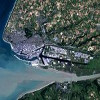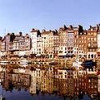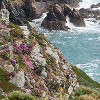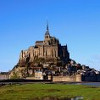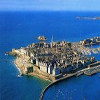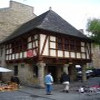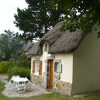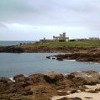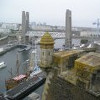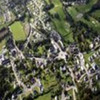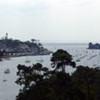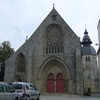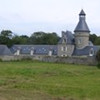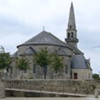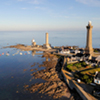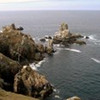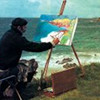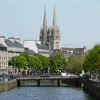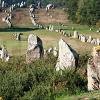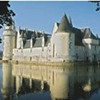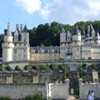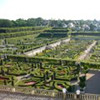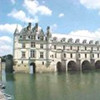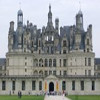BRETAGNE (FRANCE)
2007.05.21-28: Welcome to Bretagne! Introduction...
2007.05.14-28: The diary of the journey:
2007.05.14: Nürnberg
2007.05.15: Strasbourg
2007.05.16: Nancy
2007.05.16: Metz
2007.05.17: Paris
2007.05.17: Le Havre
2007.05.17: Honfleur
2007.05.17: La Côte Fleurie
2007.05.17: Mont Saint-Michel
2007.05.18: Saint-Maloù
2007.05.18: Dinan
2007.05.18: Trégunc and one week in Ruat Vraz (18-24 August)
2007.05.19: Concarneau - Fête des Filets Bleus
2007.05.19: Pointe de Trévignon
2007.05.20: Brest
2007.05.20: Brest - Oceonopolis
2007.05.22: Clohars-Fouesnant
2007.05.22: Bénodet
2007.05.22: Pont l'Abbé
2007.05.22: Manoir de Kerazan
2007.05.22: Loctudy
2007.05.22: Penmarc'h
2007.05.22: Pointe du Raz
2007.05.22: Pointe du Van
2007.05.23: Pont Aven
2007.05.23: Quimper
2007.05.25: Megaliths of Carnac
2007.05.25: Château du Plessis-Bourré
2007.05.25: Château d'Ussé
2007.05.25: Château de Villandry
2007.05.25: Château de Chenonceau
2007.05.25: Château de Chambord
2007.05.21-28: External links
Welcome to Bretagne!
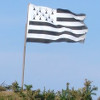
The region of Bretagne is made up of 80% of the former duchy and province of Brittany. The remaining 20% of Brittany is the Loire-Atlantique department which lies inside the Pays-de-la-Loire region, with its capital Nantes, which was the historical capital of the duchy of Brittany.
Part of the reason why Brittany was split between two modern day regions was to avoid the rivalry between Rennes and Nantes. Although Nantes had been the main capital of the duchy of Brittany until the 16th century, Rennes had been the seat of the supreme court of justice of Brittany between 1560 and 1789. Rennes had also been the administrative capital of the Intendant of Brittany between 1689 and 1789. Intendances were the most important administrative units of the kingdom of France in the 17th and 18th centuries. As for the provincial states of Brittany, which originally met every two years in a different city of Brittany, they had only met in Rennes from 1728 to 1789 (with only the exceptions of 1730, 1758, and 1760). Despite that, the "Chambre des comptes" stayed in Nantes until 1789. Note that Vannes (Gwened in Breton) used to be the first administrative capital of the duchy from 1381 till the end of the 15th century, keeping the seat of the "Chambre des comptes" till 1491/99, and the one of the "Parlement" till 1553, and between 1675 and 1689.
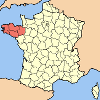
Some people in Brittany complain about the current division of Brittany and would like to see Loire-Atlantique joining the region of Bretagne in order to reunify Brittany. However, reunification raises a couple of questions: first, what to do with the rump Pays-de-la-Loire region, and second, which city should be chosen as the capital of this reunified Bretagne region.
Two regional languages are recognized by the region. Breton, a Celtic language (akin to Cornish and Welsh), is spoken in the western part of Brittany (roughly, west of a boundary from St Brieuc to Vannes). In the part of Brittany which never spoke Breton, Gallo, an Oïl language, is also in the process of being revived, as a cultural trait of that part of Brittany.
Modern French administration now allows for some Breton or Gallo to be used by the region and its communes, in road signs and names of towns and cities, along with the French version. They are also taught at school, and many folklore associations and clubs try to re-invigorate them.
Brittany was a usually conservative region, with the notable exception of Cotes-d'Armor, a longtime stronghold of the left. However, Brittany is slowly trending to the left, electing the first socialist in its history to regional presidency and voted for Ségolène Royal in the French presidential election, 2007 (except in Morbihan). Centrist candidate Francois Bayrou also polled relatively high in the region and Fougères elected a Mouvement Democrate deputy to the National Assembly. The region was one of the few regions to vote yes to the European constitution in the 2005 referendums.
Journey's diary (2007.05.14-28)
Nürnberg (2007.08.14)
Nürnberg (14th August 2007) - Nürnberg (Nuremberg) is nearly 1000 years old, on 16 July, 1050, the freeing of a serf by the name of Sigena was documented in "Norenberc". This date of the first written mention of Nuremberg is assumed to be the day of the foundation of the city. In the Middle Ages, Nuremberg was appointed the place where each newly elected German king had to hold his first diet, and where the crown jewels of the empire were kept. The city, dominated by the leading trading and merchant families, had its economic and cultural heyday in the late 15th and early 16th century.
World-famous artists such as Albrecht Dürer and Veit Stoß, humanists such as Willibald Pirckheimer and scientists such as the astronomer Johannes Regiomontanus lived and worked in this city. In the 19th century, Nuremberg entrepreneurial spirit triggered off a new rise in the city's fortunes: the first German railway between Nuremberg and Fürth in 1835 became a symbol for this Bavarian industrial center.
In the 20th century, the National Socialists abused the city for their purposes. Adolf Hitler made Nuremberg "City of the Party Rallies", and it was here that the atrocious racial laws were adopted, and the main war criminals of the Nazi regime of terror were tried by the International Military Tribunal in the "Nuremberg Trials". The city which was badly damaged by bombs during World War II, today presents itself as a successful blend. See more ...
Strasbourg (2007.08.15)
Strasbourg (15th August, 2007) - Culture and the arts are indissociable in Strasbourg. The wealth of its heritage is enhanced by the dynamism and diversity of its cultural life. Throughout the year, the city offers a very broad range of cultural events. Although music is the queen, the plastic arts, theater, dance, variety, and literature are enthusiastically celebrated in the Alsatian capital, to the tune of an annual average of almost ten events a day offered to the public.
In the artistic life of the French regions, Strasbourg occupies a special place. It plays host to numerous cultural institutions whose reputation extends beyond national borders: with the Opéra National du Rhin, the Philharmonic Orchestra and Les Percussions de Strasbourg, fans will not be disappointed.
Each establishment adds its own special touch to the city's profusion of culture. From the Maillon to the Laiterie, taking in the Théâtre Jeune Public, Pôle Sud, the Théâtre Municipal, the Théâtre National de Strasbourg (Strasbourg National Theatre / TNS) and its stage school, the Conservatoire National de Région (National Regional Conservatoire), and the Palais de la Musique et des Congrès (Music and Congress Centre), Strasbourg is a place which welcomes art and artists in a continual search for original artistic creations and strong emotions.
Thanks to the Festival International de Musique, to Musica, to Jazz d'Or, the city attracts artists from all media and continues to provide a nursery for talent from all areas of the arts. The Museums of Strasbourg also offer a varied choice to art lovers and those eager to learn. They put on a great number of exhibitions on an ongoing basis, often in partnership with overseas museums. From the Musée des Beaux-Arts (Fine Arts Museum) to the Musée Historique (Historical Museum), taking in the Musée de l'Oeuvre Notre Dame (Museum of the Work of Notre Dame), the Musée Alsacien (Alsatian Museum), the Musée Archéologique (Archaeological Museum), the Musée des Arts Décoratifs (Museum of Decorative Arts), everyone will find something that he can cherish. The newest museum, the Musée d'Art Moderne et Contemporain (Museum of Modern and Contemporary Art) offers visitors an artistic journey covering the period from 1870 to the present day. On show are works by Gustave Doré, Jean Arp, Max Ernst, Rantisek Kupka, Wassily Kandinsky, Robert Filliou and Sarkis.
Numerous establishments of higher artistic education complete this cultural network: a national school of dramatic art, a college devoted to the decortive arts, a national music conservatoire and a school of architecture.Strasbourg also houses the second largest national university library in France with more than three million titles. See more ...
Nancy (2007.08.16)
Nancy (16th August, 2007) - The earliest signs of human settlement in the area date back to 800 BC. Early settlers were likely attracted by easily mined iron ore and a ford in the Meurthe River. A small fortified town named Nanciacum (Nancy) was built by Duke Gérard around 1050. Nancy was sacked by Emperor Frederick II in the 13th century, then rebuilt in stone over the next few centuries as it grew in importance as the capital of the Duchy of Lorraine. Charles the Bold, Duke of Burgundy, was defeated and killed in the Battle of Nancy in 1477. With the death of Duke Stanislas in 1766, the duchy became a French province and Nancy remained its capital. When the région of Lorraine was created in the middle of the 20th century, Metz was chosen as its capital instead of Nancy. As unrest surfaced within the French armed forces during the French Revolution, a full-scale mutiny took place in Nancy in later summer 1790. A few reliable units lay siege to the town and shot or imprisoned the mutineers.Nancy was captured from Nazi Germany by the U.S. Third Army in September of 1944, during the Lorraine Campaign of World War II.
The Place Stanislas named after the Polish king and duke of Lorraine Stanislaw Leszczynski, Place de la Carrière, and Place d'Alliance were added on the World Heritage Sites list by the UNESCO in 1983. The "École de Nancy", a group of artists and architects founded by the glassmaster and furniture maker Émile Gallé, worked in the Art Nouveau style at the end of the 19th century and the early 20th century. It was principally their work which made Nancy a centre of art and architecture that rivaled Paris and helped give the city the nickname "Capitale de l'Est." The city still possesses many Art Nouveau buildings (mostly banks or private homes). Furniture, glassware, and other pieces of the decorative arts are conserved at the Musée de l'École de Nancy, which is housed in the 1909 villa of Eugène Corbin, a Nancy businessman and supporter of the Art Nouveau there. The old city centre's heritage dates from the Middle Ages to the 18th century. The cathedral of Nancy is a fine example of 18th century architecture. The surroundings of the train station are a busy commercial area. There is also a botanical garden in Nancy, "Le Jardin Botanique". It is open from 10 am to 12 (noon), and from 2 pm to 5 pm on Mondays through Fridays. On Saturdays and Sundays it is open from 2 pm to 5 pm. It costs around 2.30 euros to enter, and has many different types of plants, including tropical, and many other wonderful types of plants and flowers. There is also the aquarium and various other public gardens and places of interest including the Pépinière and Parc Sainte-Marie (public gardens); the Musée de l'École de Nancy, the Musée des Beaux-Arts and the Musée Lorrain amongst others. See more ...
Metz (2007.08.16)
Metz (16th August, 2007) - Metz is a city in the northeast of France, capital of the Lorraine région and of the département of Moselle (57). It is located at the confluence of the Moselle and the Seille rivers. Although historically Nanzig (Nancy) was the capital of the duchy of Lotharingia, it was Metz which was chosen as the capital of the newly created région of Lorraine in the middle of the 20th century.
At the confluence of two rivers, the river Moselle and the river Seille, rises a strategic hill. The funeral urns found by archaeologists indicate that men of the late bronze age settled down there. It was three thousand years ago!During the 5th century B.C, the celtic tribe named Mediomatrics occupied the site. The gallic oppidum (sort of town) became the gallo-roman city of Divodorum Medimatricorum after Caesar's conquest of Gaul. Iron, salt, vineyards, pottery ... sustained the economy of a roman province city which kept on prospering until the middle of the third century. Roads, aqueducts, roman baths, an amphitheatre of 25000 seats (the same size as Verona's !) ... indicate a first rate city. That would be partly ruined by the barbarian invasions. At the beginning of the 6th century, Metz became the capital of the merovingian kingdom of Austrasia. In 640 Arnould, bishop of Metz died. He was the great-great grandfather of the famous Charles Martel, himself grandfather of Charles the Great. The carolingian rebirth saw Metz and its bishop Chrodegang create a plainchant school which spread gregorian chant through all Christendom.
- 814 death of Charles the Great; his son Louis le Pieux inherits the empire.
- In 842, after Louis le Pieux’s death (840), the oath of Strasbourg was taken. It was the first text in romanesque language, written in messin dialect and the first division of Charles the Great's empire between two of the three sons of Louis le Pieux...
- In 843, the carolingian empire was divided into three parts (one person) The kingdom of Lotharingia was created - Metz sharing its destiny.
- Around the year 1000, three bishoprics were created. The bishop of Metz was a prince of the Empire and exercised all the powers. During the Middle-Ages, the bourgeoisie became emancipated. In 1179, Bertram, bishop of Metz, organized the election of the mayor. Metz, soon a republican city, would go through its wealthiest period up to the 15th century.
- In 1552, Charles V besieged the city, defended by the Duke of Guise. The joining to France would be confirmed under Louis XIII, in 1648, at the end of the Thirty Years war. Metz was again fortified, and Vauban said : " Fortified places of the kingdom defend their provinces, Metz defends the State."
- Metz grew until the 19th century and made big profits with coal and steel industries and the arrival of the railway. 1870-1871 : the defeat : Metz was annexed by Germany until 1918. After half a century, the city was French again. 1940-1944 : new annexation...
- After World War II, Metz developed its economy more and more and gave up step by step its strategic and military vocation. It became the capital of the Lorraine region, with 200,000 inhabitants, and is known as the city of communication and new technologies.
Paris (2007.08.16-17)
Paris (16th-17th August, 2007) - Paris is the capital city of France. It is situated on the River Seine, in northern France, at the heart of the Île-de-France region ("Région parisienne"). Paris has an estimated population of 2,153,600 within its administrative limits. The Paris Unité urbaine (or "urban unit") is an area of unbroken urban growth that extends well beyond its city limits, with a population of 9.93 million. A commuter belt around the same completes the Paris urban area (similar to a metropolitan area) that, with its population of 12 million, is one of the most populated areas of its kind in Europe. An important settlement for more than two millennia, Paris is today one of the world's leading business and cultural centres, and its influence in politics, education, entertainment, media, fashion, science and the arts all contribute to its status as one of the world's major global cities.
The Paris region (Île-de-France) is France's foremost centre of economic activity. With €478.7 billion (US$595.3 billion), it produced more than a quarter of the gross domestic product (GDP) of France in 2005. With La Défense, the largest purpose-built business district in Europe, it hosts the head offices of almost half of the major French companies, as well as the headquarters of fifteen of the world's 100 largest companies. Paris also hosts many international organizations such as UNESCO, the OECD, the ICC, or the informal Paris Club.
With over 30 million foreign visitors per year, Paris is the most popular tourist destination in the world. The city hosts numerous iconic landmarks such as the Eiffel Tower, Notre Dame cathedral, the Champs-Elysées, the Arc de Triomphe, the Basilica of the Sacré Cœur, the Invalides, the Panthéon, the Grande Arche and the Opéra Garnier among its many attractions, along with world famous institutions such as the Louvre, the Musée d'Orsay or the Musée National d'Art Moderne, and popular parks like Disneyland Resort Paris. See more ...
,Le Havre (2007.08.17)
Le Havre (17th August 2007) - Le Havre is a city in Normandy, northern France, on the English Channel, at the mouth of the Seine. Population of the city (commune) at the 1999 census was 190,905 inhabitants (186,700 inhabitants as of February 2004 estimates). Population of the whole metropolitan area (aire urbaine) at the 1999 census was 296,773 inhabitants. It was the port-of-call for French ocean liners making the Transatlantic crossing (cf Cruise ship). Le Havre is known as "La Porte Océane". It is the largest city in Normandy before Rouen. It is the first largest export port in France. Le Havre has been classified as a World Heritage Site since July 2005. The city has one university and a strong sporting heritage, with “Le HAC”, the oldest professional association football club in France.
The city was founded in 1517, when it was named Franciscopolis after Francis I of France, and subsequently named Le Havre-de-Grâce ("Harbor of Grace"; hence Havre de Grace, Maryland). Le Havre simply means the harbour or the port. Its construction was ordered to replace the ancient harbours of Honfleur and Harfleur whose utility had decreased due to silting. The history of the city is inextricably linked to its harbour. In the 18th century, as trade from the West Indies was added to that of France and Europe, Le Havre began to grow. During the 19th century, it became an industrial center. The city was devastated during the Battle of Normandy: 5,000 people were killed and 12,000 homes were totally destroyed. The center was rebuilt in modernist style by Auguste Perret. It was designated UNESCO World Heritage Sites in 2005. See more ...
Honfleur (2007.08.17)
Honfleur (17th August 2007) - The Harbor, the Old Dock and Sainte Catherine's Church... are among the famous places that you can see in Honfleur. Carte-Postale.com invites you for a tour of Honfleur. This virtual visit will be only the first step, and hopefully, you will be soon among the numerous France lovers who choose to come and stay in one of the most attractive cities of Normandy: Honfleur.
The Old Dock is the heart of the city. It is the most symbolic place of Honfleur with the very typical high houses all around the dock.
The Lieutenance, formerly House of the King's Lieutenant in Honfleur, used to be part of the ramparts surrounding the city and is now almost the only remaining part with the Gate to Caen.
Dig in 1684 as ordered by Colbert, the Old Dock is particularly appreciated for its changing light and reflects and still attracts painters and photographers, as it attracted the famous impressionists Eugène Boudin, Claude Monet, and many others who followed their steps. See more ...
La Côte Fleurie (2007.08.17)
La Côte Fleurie (17th August 2007) - Côte Fleurie is part of the Normandy coast on the English Channel in the North of the Pays d'Auge, it constitutes the Eastern coast of Calvados.
The name is a reference to the green and flowered countryside of the country lying beyond the coastal hills and to the numerous resorts along the coast.
From East to West, these are: Honfleur, Villerville, Trouville sur Mer, Deauville, Bénerville-sur-Mer, Tourgéville, Blonville-sur-Mer, Villers-sur-Mer, Houlgate, Dives-sur-Mer, Cabourg, La Home-Varaville, Merville-Franceville-Plage, Sallenelles.
The coast between the towns of Trouville and Honfleur, although part of the Côte Fleurie, is named Côte de Grace. Dives-sur-Mer is on the Côte Fleurie but possesses no beach or seafront. It is the Brigade Piron that liberated the Côte Fleurie in September 1944. See more ...
Mont Saint-Michel (2007.08.17)
Mont Saint-Michel (17th August 2007) - Mont Saint-Michel (English: Mount Saint Michael) is a rocky tidal island in Normandy, roughly one kilometre from the north coast of France at the mouth of the Couesnon River near Avranches.
In prehistoric times the bay was land, as sea levels rose erosion shaped the coastal landscape over millions of years. Several blocks of granite or granulite emerged in the bay, having resisted the wear and tear of the ocean better than the surrounding rocks. These included Lillemer, the Mont-Dol, Tombelaine and Mont Tombe, later called Mont Saint-Michel.
Mont Saint-Michel was previously connected to the mainland via a thin natural land bridge, which before modernization was covered at high tide and revealed at low tide. Thus, Mont Saint Michel gained a mystical quality, being an island half the time and being attached to land the other: a tidal island.
However, the insular character of the mount has been compromised by several developments. Over the centuries, the coastal flats have been polderised to create pasture. The south coast of Mont-Saint-Michel has thus become farther to the shore and the mount. The Couesnon River has been canalised, reducing the flow of water and thereby encouraging a silting-up of the bay. In 1879, the land bridge was fortified into a true causeway. This prevented the tide from scouring the silt round the mount. There are currently plans to remove the causeway and replace it with a bridge and a shuttle. On 16 June 2006, the Prime Minister of France, Dominique de Villepin, announced a €150 million project (Projet Mont Saint-Michel) to build a hydraulic dam that will help remove the accumulated silt and make Mont Saint-Michel an island again. It is expected to be completed by 2012. See more ...
Saint-Maloù (2007.08.18)
Saint-Maloù (18th August 2007) - Saint-Malo during the Middle Ages was a fortified island at the mouth of the Rance River, controlling not only the estuary but the open sea beyond. The promontory fort of Aleth, south of the modern centre in what is now the Saint-Servan district, commanded approaches to the Rance even before the Romans, but modern Saint-Malo traces its origins to a monastic settlement founded by Saint Aaron and Saint Brendan early in the 6th century. Its name is derived from a man said to have been a follower of Brendan, Saint Malo.
Saint-Malo had a tradition of asserting its autonomy in dealings with the French authorities and even with the local Breton authorities. From 1590–1594, Saint-Malo declared itself to be an independent republic, taking the motto "not French, not Breton, but Malouins".
Saint-Malo became notorious as the home of the corsairs, French privateers and sometimes pirates. (In the nineteenth century the city's "piratical" notoriety was portrayed in Jean Richepin's play Le flibustier and in César Cui's like-named opera derived therefrom.) The corsairs of Saint-Malo not only forced English ships passing up the Channel to pay tribute, but also brought wealth from further afield. Jacques Cartier, who sailed the Saint Lawrence River and visited the sites of Quebec City and Montreal — and is thus credited as the discoverer of Canada, lived in and sailed from Saint-Malo, as did the first colonists to settle the Falklands – hence the islands' French name Îles Malouines, which gave rise to the Spanish name Islas Malvinas. See more ...
Dinan (2007.08.18)
Dinan (18th August 2007) - The old town is most atmospheric, crammed full of half timbered buildings dating from the 13th and 14th centuries, with cobbled rambling streets all carefully restored and preserved. Interspersed throughout the old town are numerous individually owned cafes, bars, restaurants and the colourful shops of butchers, bakers and today scented candle-makers. The shops of florists, artisans, craftsmen and weavers mingle with the ubiquitous gift and post card shops that thrive in any town that is a magnet to tourists. Dinan’s population is now around 11,000. Its history revolves around its feuds with England. Notably, the Duke of Lancaster’s invasion of 1357 when the local hero was Bertrand Du Guesclin whose brother Oliver, having been kidnapped, was held to ransom, by his captor an English Knight, one Cambridge. Bernard challenged Cambridge in a one to one combat and won. He continued campaigning for the King of France until he died some 23 years later. His bronze statue commemorates him on that very battleground, the Place du Champs, now less importantly used as a car park, which faces both the Hotel D'Avaugour and the Cantorbury restaurant in the old town. The 1907 fire in Cordeliers’ Street apparently caused citizens to become aware of the importance of the preservation of medieval half timbered buildings to Dinan’s heritage. The first listing of a medieval house in the harbour district took place in 1928 and it was indeed great foresight to see such early attempts of conservation that deserve congratulation today.
Major historical attractions include the Jacobins Theatre dating from 1224, the flamboyant Gothic St Malo's Church, the Romanesque St Saviour's Basilica, Duchess Anne's Tower and the Château de Dinan. A major highlight in the calendar is Dinan's Fête des Remparts. The town is transformed with decoration and many locals dress up in medieval garb for this two-day festival. It occurs only every other year, which can catch visitors out. See more ...
Saint-Trégunc & Ruat Vraz (2007.08.18-24)
Trégunc & one week in Ruat Vraz (18th-24th August 2007) - Enjoying the sea, nature, sport or discovering the standing stones, an architectural specificity of the town and its neighbour Névez which give them the name of the country of the standing stones. Situated between Concarneau and Pont-Aven, Trégunc is in Finistère faced with the Glénan islands. With 23 kilometres of coast, the Atlantic Ocean presents different coastline: beaches, rocks, creeks, dunes, ports which offer you various maritime and nautical activities from relaxing under the sun to catamaran racing or fishing. At la pointe de Trévignon, the small port is a necessary stopover. Trégunchas a lot of old stones. Apart from the standing stones structures, you can see chapels, wayside crosses and ancient outside bread ovens. The area around Trégunc is a protected coastal nature zone with many species of birds and flowers. Specialist nature tour guides are available to accompany you on your walks should you wish. Between two strolls, after diving, sail boarding or a tennis competition, come and try a delicious seafood plate or some crêpes.You will soon understand and enjoy Trégunc's charms and authentic character.
Mysterious country paths invite you to a treasure trove of fountains, bread ovens, calvaries, megaliths, wells, old farms, steles, castles, citadels or standing stones! See more ...
Concarneau & Fête des Filets Bleus (2007.08.19)
Concarneau with the Fête des Filets Bleus (19th August 2007) - Concarneau (Konk Kerne in Breton, meaning Bay of Cornwall) is a commune of the Finistère département, in France. The town has two distinct areas: the modern town on the mainland and the medieval Ville Close, a walled town on a long island in the centre of the harbour. The Ville Close is now devoted to tourism with many restaurants and shops aimed at tourists. However restraint has been shown in resisting the worst excesses of souvenir shops. Also in the Ville Close is the fishing museum. The Ville Close is connected to the town by a draw bridge and at the other end a ferry to the village of Lanriec on the other side of the harbour.
In August the town holds the annual Fête des Filets Bleus (Festival of the Blue Nets). The festival named after the traditional blue nets of Concarneau's fishing fleet, is a celebration of Breton and pan-Celtic culture. Such festival can occur throughout Brittany but the Filets Bleus is one of the oldest and largest attracting in excess of a thousand costumed participants with many times the number of observers. In 2005 the 100th festival was celebrated.
Concarneau was the setting for Belgian mystery writer Georges Simenon's 1931 novel Le Chien jaune (The Yellow Dog), featuring his celebrated sleuth Inspecteur Maigret. See more ...
Pointe de Trévignon (2007.08.19)
Pointe de Trévignon (19th August 2007) - Point du Trevignon, in the south corner of Finistére. It´s a small fishing village at Atlantic. Sitting at evening in the pub at ocean, eating a Crepe, drinking a wine.... hearing the voice of ocean and birds, fishing boats... Then and there I was happy. This point has not too much tourists like the other points, so it's mostly restful. Trevignon you can reach very good from next bigger town Trégunc.
The Pointe of Trévignon gives panoramic views of the Glénan Archipelago.
Le Chateau de Trévignon is a privée Chateau - no entry allowed, but a very nice place with a green headed lighthouse on the breakwater. See more ...
Brest (2007.08.20)
Brest (20th August 2007) - Brest is a city in Brittany, or the Bretagne région, north-west France, sous-préfecture of the Finistère département. Located on the western tip of Brittany, the city is an important port and naval base. The population of the city was estimated at 146,000; the population of the metropolitan area was recorded as 303,484 inhabitants. Although the city is by far the largest in Finistère, its préfecture (capital) resides in the much smaller commune of Quimper.
Nothing definite is known of Brest until about 1240, when it was ceded by a count of Léon to John I., duke of Brittany. In 1342 John of Montfort gave it up to the English, and it did not finally leave their hands till 1397. Its medieval importance was great enough to give rise to the saying, "He is not duke of Brittany who is not lord of Brest." By the marriage of Francis I. with Claude, daughter of Anne of Brittany, Brest with the rest of the duchy definitely passed to the French crown. The advantages of the situation for a seaport town were first recognized by Richelieu, who in 1631 constructed a harbour with wooden wharves, which soon became a station of the French navy. Colbert changed the wooden wharves for masonry and otherwise improved the post, and fortifications by Vauban (1633–1707) followed in 1680-1688. During the 18th century the fortifications and the naval importance of the town continued to develop.
In 1694 an English squadron under John Berkeley, 3rd Baron Berkeley of Stratton, was miserably defeated in the Attack on Brest; but in 1794, during the revolutionary war, the French fleet, under Villaret de Joyeuse, was as thoroughly beaten in the same place by the English admiral Howe.
During World War II, the Germans held a large submarine base in Brest. Destroyed at the Battle for Brest, the city has since been rebuilt. (There were about three buildings left standing.) After the end of the war, the West German government had to pay several billion dollars of reparations as compensation to the homeless and destitute civilians in the city for any of their homes or property which were damaged or destroyed in the war. The rebuilt city consists primarily of utilitarian gray granite and concrete buildings.
In 1972, the base of the French submarine nuclear deterrence was opened at Île Longue, in the roadstead of Brest. See more ...
Brest - Oceonopolis (2007.08.19)
Brest - Oceonopolis (20th August 2007) - This vast aquarium in the port of Brest offers a brilliant day out for a family or marine-minded individual. There are 42 different aquariums of varying sizes (from 50,000 to 1 million litres), designed to reflect the diversity of the world's oceans.
Oceanopolis is divided into three pavilions, each one devoted to a different climatic zone - polar, temperate and tropical. More than 10,000 animals, from jellyfish to sharks, represent 1000 marine species. Fish and flora from the ocean are exhibited along with an interactive section which explains how the oceans' temperatures are regulated, the interdependence of species and more.
Visitors can also enjoy the multimedia bookshop dedicated to the sea, the restaurants and some wonderful views of the bay of Brest from the terrace of the eating area. Should you decide to get close to the real thing after your visit, there is a vast sandy beach nearby! See more ...
Clohars-Fouesnant (2007.08.22)
Clohars-Fouesnant (22th August 2007) - The city of Clohars-Fouesnant (Breton: Kloar-Fouenant) is included to the region Bretagne, to the department Finistère, to the borough Quimper and to the canton Fouesnant. The city of Clohars-Fouesnant covers 13.02 km² and has 2,127 inhabitants with a density of 163.36 inhabitants per km². The minimum altitude is 0 m, the maximum altitude is 71 m. Inhabitant of Clohars-Fouesnant city is called Cloharsiens.
The town of Clohars-Fouesnant, inherits a rich lord visible on the town: the castles of Kergos, Bodinio, Cheffontaines and Garennes. At the center of town, the oldest church "Saint-Hilaire" Township deserves a visit, and the fountain of the chapel Drennec. Squividan the field, with his mansion, now a museum, adds to this beautiful palette. Finally, the tip of Beg ar Vir, where the bridge of Cornwall takes off with her gite at the edge of the river Odet and boaters, is to stress that Clohars-Fouesnant is also a coastal town. Hiking trails exist already and can make beautiful walks, others in progress or planned, will soon complete the offer.
Apart from the field Squividan, the site of Beg ar Vir and churches, all the rest is privately owned and not open to visitors, except on rare occasions, when intimate visits were organized by the owners themselves or at the request of some groups and, finally, for some, during National Heritage. See more ...
Bénodet (2007.08.22)
Bénodet (22th August 2007) - Bénodet is a commune in the département of Finistère, Bretagne, France. The name Benoded means in Breton, "mouth of the Odet. It is about 16 kilometres south of Quimper. Bénodet is one of the most fashionable seasider resorts in Brittany. The town is home to a casino, a thalassotherapy, cinema, a marina, hotels and a few beaches. As with many coastal towns in Brittany, there are many second homes in the town, the population increasing sixfold over the summertime. Bénodet is also home to menhirs and a church named after Brigid of Kildare, a 5th century Irish saint; which was built at the end of the 11th century and classed as a historic monument in 1916. The town is home to the Tri Martolod brewery.
Most events in the town take place in the summertime, due to the town's bustling summer season. In May, the Odet yacht club runs the Obelix Trophy, a sailing race with about 100 boats taking part over 4 days. Every year the commune runs a series of music concerts every Friday evening, with French pop rock group Superbus playing there in 2005. Every Monday there is a market in the town centre. See more ...
Pont l'Abbé (2007.08.22)
Pont l'Abbé (22th August 2007) - Pont-l'Abbé (Pont-n'Abad in Breton means "Abbot's bridge") is a commune of the Finistère département, in France. It is the capital of the Bigouden Country. The self-styled capital of Bigouden (roughly the region between the river Odet and the Bay of Audierne), Pont-l'Abbé was founded by the monk of Loctudy who built the first bridge across the river estuary (hence the name). The monk also built the castle, which dates originally from the 14th century.
Monuments: The Pont-l'Abbé's castle (City hall and Bigouden museum, a very nice collection of costumes and Bigouden head-dresses), castle from the 14th and 18th centuries. The "wedding" room decorated with Mathurin Méheut pieces of art (Sainte-Marine port), Henri Sollier and Jacques Godin. The'Notre-Dame des Carmes's church, old church from the 16th century (1383-1420). With a gothic style, it has many old statues and a very nice rose window over the high altar considered to be the loveliest of Bretagne. The'Lambour' church(13th-16th century) the roof had been removed in 1675 under Louis XIV's reign in reprisal of the "Bonnets Rouges" revolution. The Monument aux Bigoudens, master piece in granit stone by François Bazin (1931), shows a group of five Bigoudènes in traditional costume from the begenning of XXth century (four women and a child) all of them thinking of their sons, father, husband or grand child, fighting on the high sea against the storm. The Manoir de Kernuz, restaured around 1850 by the historian of Brittany, Armand du Chatellier. See more ...
Manoir de Kerazan (2007.08.22)
Manoir de Kerazan (22th August 2007) - Set in the grounds of an 18th-century manor house, the only fully-furnished manor house in Finistère, this five-hectare English-style park is perfect for walkers with its dry moat, paths lined with centuries-old trees, old-style vegetable garden, rockery, washhouse, boxwood maze and farm with animals.
Just minutes from the beach in Locturdy just south of Pont-l'Abbé, the stately Manoir de Kerazan invites you to discover the days of yore in a Bretton country manor house. A wing of the manor dates back to the 16th century and it is representative of the Second Empire style. This elegant family dwelling of great character is home to a prestigious group of paintings and a unique collection of pottery. You can also spend time walking the attractive grounds. See more ...
Loctudy (2007.08.22)
Loctudy (22th August 2007) - Loctudy is a delightful seaside resort in the south of the «Pays Bigouden», near Pont l’Abbe. Its emblem, the Dublin bay prawn (named as well “The young lady of loctudy”, isn’t without remembering one of its main economical activities, fishing. With its vast 12 kms coastal footpath, Loctudy offers to its visitors a large number of seaside leisure: for the walkers, the beauty of the landscape and for the swimmers, a calm sea with light sea spray.
The «Pays Bigouden» sets in the south west bow of the Brittany peninsula and gather 3 cantons (Le Guilvinec, Pont l'Abbé, Plogastel-St-Germain). These are equally divided in 22 country villages which are symbolised by 22 red ermines engraved on the blazing flag of this country.
The «Pays Bigouden» (in Breton «Ar vro vigoudenn») opens its gates: come and discover this unique culture, established in the St-Guénolé’s rock and strongly marked by the biting winds of "La Torche" (an international spot for the surfers)! See more ...
Penmarc'h (2007.08.22)
Penmarc'h (22th August 2007) - Penmarc'h or Penmarch (the apostrophe in the name is correct) is a village and commune of western France in the département of Finistère, 18 m. SW of Quimper by road. Pop. (1906), of the village, 387; of the commune, 5702. It is the most populated commune in Guilvinec. On the extremity of the peninsula on which it is situated are fortified remains of a town which was of considerable importance from the 14th to the 16th centuries and included, besides Penmarc'h, Saint-Guénolé and Kerity. It owed its prosperity to its cod-banks, the disappearance of which together with the discovery of the Newfoundland cod-banks and the pillage of the place by the bandit La Fontenelle in 1595 contributed to its decadence. The church of St. Nouna, a Gothic building of the early 16th century at Penmarc'h, and the church of St. Guenole, an unfinished tower, and the church of Kerity are of interest. The coast is very dangerous. On the Point de Penmarc'h stands the Phare d'Eckmuhl, with a light visible for 60 miles. There are numerous megalithic monuments in the vicinity. See more ...
Pointe du Raz (2007.08.22)
Pointe du Raz (22th August 2007) - The Pointe du Raz is a promontory that extends into the Atlantic from western Brittany. It is named after the Raz de Sein, the dangerous stretch of water between it and the island of Sein. It is a dramatic place of crashing waves and strong winds.
On the western tip of France is the Pointe du Raz, which is named after the Raz de Sein, the dangerous stretch of water between it and the island of Sein. The Pointe sits on a steep cliff 70 m above the stormy waves of the Atlantic Ocean. The southern side of the peninsula is dotted with picturesque fishing villages and resorts. The cliff formations near the fishing harbour of St. Guénolé are particularly rugged. Stretches of cliffs alternate with stretches of golden beaches. Ferries depart from Audierne to the pounding shores of Ile de Sein. See more ...
Pointe du Van (2007.08.22)
Pointe du Van (22th August 2007) - The Baie des Trépassés - The lovers of grandiose will enjoy the beauty of the landscape of the Pointe du Van and the Baie des Trépassés where walkers and surfers pass each other. The picturesque fishing harbours nestled in the rocky bays and the pretty chapels in the countryside are places to visit. Their tables are famous for their seafood, including oysters and shellfish, but you can also discover the thousands of flavours from our area with our wheat and buckwheat crepes. The Pointe du Van and the chapel Saint They. The cliffs of Castelmeur, Brezellec, Penham and their small harbours. The church Saint Clet (XVI century), the chapels of Langroas and Saint Tugdual and the Baie des Trépassés. See more ...
Pont Aven (2007.08.23)
Pont Aven (23th August 2007) - Pont-Aven is a commune of the Finistère département, in Brittany, France. Pont-Aven is mainly known because of the group of artists who flocked round Émile Bernard and Paul Gauguin, and who were joined in 1888 by Paul Sérusier. They were collectively known as "Pont-Aven School" (French: École de Pont-Aven). Pont Aven was the site of L'Aven Project by artist John K Melvin. This month-long art installation was on view to the public from July 29 to September 4, 2006. Conferences and a catalog accompanied the installation. The Aven River runs through Pont-Aven. The river has relatively favourable water quality, with pH levels slightly alkaline at about 8.5 and electrical conductivity of 19 micro Sienens per centimeter. Before Pont Aven attracted Gauguin and other artists it was a centre for milling with the river Aven being divided above the town to provide a mill race which powers a series of water mills. Whilst several of these retain their wheels only the last, the Moulin Poulguin is still capable of operating. The mill is now a restaurant and you can see the machinery inside. Just outside the town is the beech woods of the Bois d'Amour. The town is close to Domaine de Kerlann Holiday Centre. See more ...
Quimper (2007.08.23)
Quimper (23th August 2007) - The name Quimper comes from the Breton kemper "confluent" because the city was built on the confluence of the Steir, the Odet and the Jet rivers. Quimper, the capital of the Département of Finistere, is situated in a pretty valley at the confluence of the Odet and Steir river estuaries, in the southwestern corner of Brittany. It is the ancient capital of La Cornouaille, Brittany’s most traditional region, and has a distinctive Breton character. It is at the intersection of Route National 165, D785, D765 and D783, 34 miles northwest of Lorient, 111 miles west of Rennes and 303 miles west-southwest of Paris.
Quimper was originally settled during Roman times. Its name was derived from the Breton word ‘Kemper’, meaning the confluence (of two rivers). By AD 495, the town had become a Bishopric. It subsequently became the capital of the counts of Cornouailles. In the 11th century, it was united with the Duchy of Brittany. During the civil wars of the 14th century, the town suffered considerable ruin. In 1364, the duchy passed to the House of Montfort.
The town has a rustic atmosphere with charming footbridges spanning the rivers that flow through it. The Church of Locmaria, a Romanesque structure, dates from the 11th century. The Cathedral of Saint-Corentin, with its magnificent Gothic-style façade, was constructed between the 13th and 16th centuries. It is the oldest Gothic structure in Lower Brittany. Its two towers are 250 feet tall; its spires were added in the 19th century. The 15th century stained glass windows are exceptional. The cathedral is dedicated to Quimper’s first bishop, Corentin.
To the cathedral’s west are the pedestrianized streets of Vieux Quimper with a wide array of crêperies, half-timbered houses and shops. Near the Episcopal palace, which now holds the Musée départemental Breton [devoted to regional history, archaeology, ethnology and economy] are the ruins of the town’s 15th century walls. Nearby is the Musée des Beaux-Arts. The museum has a 19th century façade and an entirely rebuilt interior. It houses a collection of 14th to 21st century paintings that includes works by Boucher, Corot, Oudry and Rubens along with canvases by such Pont-Aven school painters as Bernard, Denis, Lacombe, Maufra and Sérusier.
The town's best known product is Quimper faïence pottery. It has been made here since 1690, using bold provincial designs of Jean-Baptiste Bousquet. The town’s eating establishments boast of some of the best crêpes and cider in Brittany. The town has also been known for copper and bronze work, food items, galvanized ironware, hosiery, leather, paper and woolen goods. See more ...
Megaliths of Carnac (2007.08.25)
Megaliths of Carnac (25th August 2007) - The Carnac stones are an exceptionally dense collection of megalithic sites around the French village of Carnac, in Brittany, consisting of alignments, dolmens, tumuluses and single menhirs. The more than 3,000 prehistoric standing stones were hewn from local rock and erected by the pre-Celtic people of Brittany, and are the largest such collection in the world. Local tradition claims that the reason they stand in such perfectly straight lines is that they are a Roman legion turned to stone by Merlin — Brittany has its own local versions of the Arthurian cycle. Most of the stones are within the French commune of Carnac, but some to the east are within La Trinité-sur-Mer.
The stones were erected at some stage during the Neolithic period, probably around 3300 BC, but some may date to as old as 4500 BC. In recent centuries, many of the sites have been neglected, with reports of dolmens being used as sheep shelters, chicken sheds or even ovens. Even more commonly, stones have been removed to make way for roads, or as building materials. The continuing management of the sites remains a controversial topic. See more ...
Château du Plessis-Bourré (2007.08.25)
Château du Plessis-Bourré (25th August 2007) - No doubt made wealthy by his important position as treasurer and chief advisor to King Louis XI, Jean Bourré acquired the estate of Plessis-le Vent in 1462. In 1468, he started building the current chateau on the site of this ancient manor. It only took five years for the building of this masterpiece to be complete. It has never been altered since that time, so that we can still admire it as it was originally built, more than 500 years ago! Le Plessis-Bourré is the perfect example of the Transition style. Its imposing defensive system, including its impressive double draw-bridges , its very wide moats, its wall-walk, its corner-towers and its keep, classify it as a stronghold dating from the end of the Middle Ages. However, its elegance, its majestic courtyard, its covered promenade, its large rooms lit by high mullioned windows, its sumptuous decoration and the comfort of its interiors enjoyed by many French kings, all these features speak of the Renaissance.
The chateau's existence has been threatened several times during the centuries. Ownership changed several times until Monsieur Vaïsse, the grandfather of the current owners, took possession in 1911. He was a great art lover and brought the chateau back to life, restoring it in the image of the original and furnishing it with taste. This is the reason why it was chosen for classification as a historic monument in 1931. Requisitioned during the First World War, it served as a hospital for treating the injured and sick. During the Second World War, it was used to house the American Embassy to Poland and suffered no damage. When Monsieur Vaïsse died, his nephew, the Duke of Dalmatia, succeeded him and opened the chateau to the public in 1955. Today, his descendants, the Reille-Soult de Dalmatie family, represented by the family of Antoinette and Bruno de Ferrières de Sauvebeuf, who live in the chateau throughout the year, have taken over responsibility for preserving its authentic and family character. See more ...
Château d'Ussé (2007.08.25)
Château d'Ussé (25th August 2007) - The Château d'Ussé is located in the commune of Rigny-Ussé in the Indre-et-Loire département, in France.
An 11th century stronghold for the Comte de Blois, the first castle was built on a high terrace at the edge of the Chinon forest overlooking the Indre Valley. In the 15th Century Ussé was purchased by the Bueil family.
Antoine de Bueil rebuilt Ussé in the 1460s. Antoine was heavy in debt and in 1485, sold the château to Jacques d’Espinay. Jacques continued work on the castle. See more ...
Château de Villandry (2007.08.25)
Château du Plessis-Bourré (25th August 2007) - The Château de Villandry is located in Villandry, in the département of Indre-et-Loire, France. The lands where an ancient fortress once stood were known as Colombier until the 17th century. Acquired in the early 1500’s by Jean Le Breton, France’s Controller-General for War under King Francois I, a new château was constructed around the original 14th-century keep where King Philip II of France once met Richard I of England (“the Lionhearted”) to discuss peace. The castle remained in the Le Breton family for more than two centuries until it was acquired by the Marquis de Castellane. During the French Revolution the property was confiscated and in the early 1800’s Emperor Napoleon acquired it for his brother Joseph Bonaparte. In 1906, Dr. Joachim Carvallo purchased the property and poured an enormous amount of time, money and devotion into repairing the castle and creating what many consider to be the most beautiful gardens anywhere. Its famous Renaissance gardens include a water garden, ornamental flower gardens, and vegetable gardens. The gardens are laid out in formal patterns created with low box hedges. In 1934, Château de Villandry was designated a Monument historique. Like all the other castles of the Loire Valley, it is a World Heritage Site. Still owned by the Carvallo family, the Château de Villandry is open to the public and is one of the most visited castles in France. See more ...
Château de Chenonceau (2007.08.25)
Château de Chenonceau (25th August 2007) - The Chateau Chenonceau, near the small village of Chenonceau, in the Indre-et-Loire département of the Loire Valley in France, was built on the site of an old mill on the River Cher. The original castle was torched by Royal troops at the beginning of the 15th century. An attempt to rebuild it was made by Pierre Marques, but he went bankrupt leaving behind little more than a pile of rubble. Subsequently, the castle was purchased by Thomas Bohier, Chamberlain for King Charles VIII of France who built an entirely new residence beginning in 1521. Eventually, the chateau was seized by King François I for unpaid debts to the Crown, and after François' death, King Henri II offered the chateau as a gift to his mistress, Diane de Poitiers who became fervently attached to the chateau and its view along the river. She would have the arched bridge constructed, joining the chateau to its opposite bank. She then oversaw the planting of extensive flower and vegetable gardens along with a variety of fruit trees. Set along the banks of the river, but buttressed from flooding by stone terraces, the exquisite gardens were laid out in four triangles. After King Henri died, his widow, the strong-willed Catherine de Medici, had Diane de Poitiers removed to the Chateau Chaumont. Queen Catherine made it her own favorite residence, adding a series of gardens as well. As Regent of France, Catherine would spend a fortune on the chateau and on spectacular nighttime parties. In 1560, the first ever fireworks display seen in France took place during the celebrations marking the ascension to the throne of Catherine's son François II. On Catherine's death the chateau went to her daughter-in-law, Louise de Lorraine, wife of King Henri III. At Chenonceau Louise was told of her husband's assassination and she fell into a state of depression, spending the remainder of her days wandering aimlessly along the chateau's vast corridors dressed in mourning clothes amidst somber black tapestries stitched with skull and crossbones. Another mistress took over in 1624, when Gabrielle d'Estrée, the favourite of King Henri IV, inhabited the castle. After that, Chenonceau was abandoned to a forlorn darkness for more than a hundred years until a wealthy noble bought it in 1732. George Sand's grandmother, Madame Dupin, saved it from destruction during the French Revolution. She was able to preserve it from being destroyed by the Revolutionary Guard because it was essential to travel and commerce being the only bridge across the river for many miles. In 1864, Daniel Wilson, a Scotsman who had made a fortune installing gaslights throughout Paris, bought the chateau for his daughter. In the tradition of Catherine de Medici, she would spend a fortune on elaborate parties to such an extent that her finances were depleted and the chateau was seized and sold to an American. In 1913, the Menier family, famous for their chocolates, bought the chateau and still own it to this day. During World War I the gallery was used as a hospital ward; during the Second War it was a means of escaping from the Nazi occupied Vichy zone on one side of the River Cher to the free zone on the opposite bank. An archictectural mixture of late Gothic and early Renaissance, Chateau Chenonceau and its gardens are open to the public. Other than the Royal Palace of Versailles, Chenonceau is the most visited chateau in France. See more ...
Château de Chambord (2007.08.25)
Château de Chambord (25th August 2007) - Château de Chambord at Chambord, Loir-et-Cher, France is one of the most recognizable châteaux in the world because of its very distinct French Renaissance architecture that blends traditional French medieval forms with classical Italian structures. It is the largest castle in the Loire Valley, but was built to serve only as a hunting lodge for King François I, who maintained his royal residences at Château de Blois and at Château d'Amboise. The original design of the Château de Chambord is attributed, though with several doubts, to Domenico da Cortona, whose wooden model for the design survived long enough to be drawn by André Félibien in the seventeenth century. Some authors, though, claim that the renaissance french architect Philibert Delorme had a considerable role in the Château's design. Chambord was altered considerably during the twenty years of its construction (1519 ‑ 1547), during which it was overseen on-site by Pierre Nepveu. In 1913 Marcel Reymond first suggested that Leonardo da Vinci, a guest of King François at Clos Lucé near Amboise, was responsible for the original design, which reflects Leonardo's plans for a château at Romorantin for the King's mother, and his interests in central planning and double helical staircases; the discussion has not yet concluded. Nearing completion, King François showed off his enormous symbol of wealth and power by hosting his old enemy, Emperor Charles V at Chambord. See more ...
External links
www.nuernberg.de
www.strasbourg.fr
www.nancy.fr
www.metz.fr
www.paris.fr
www.lehavre.fr
en.ot-honfleur.fr
www.ot-montsaintmichel.com
www.ville-saint-malo.fr
www.mairie-dinan.com
www.tregunc.fr
www.concarneau.org
www.oceanopolis.com
www.cc-paysfouesnantais.fr
www.benodet.fr
www.ot-pontlabbe29.fr
www.loctudy-location.info
www.pointeduraz.fr
www.pontaven.com
www.quimper.fr
www.megalithia.com
www.brittanytourism.com
www.finisteretourisme.com
www.finistere-tourisme.info
www.cybevasion.com
www.plessis-bourre.com
www.chateaudusse.fr
www.chateauvillandry.com
www.chenonceau.com
www.chambord.org
